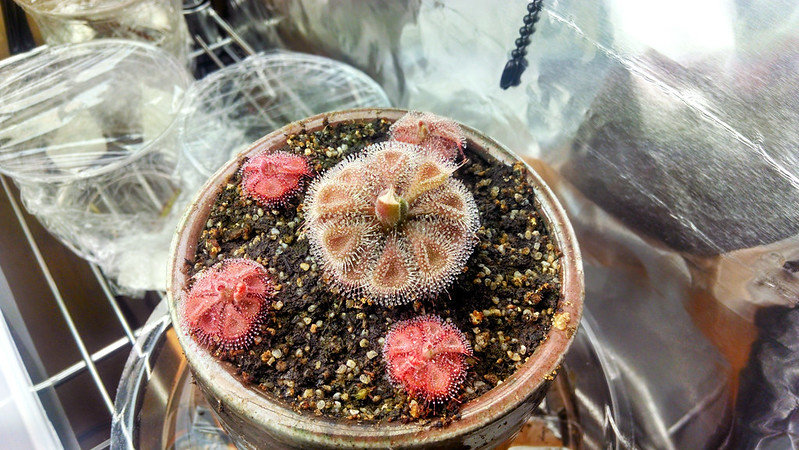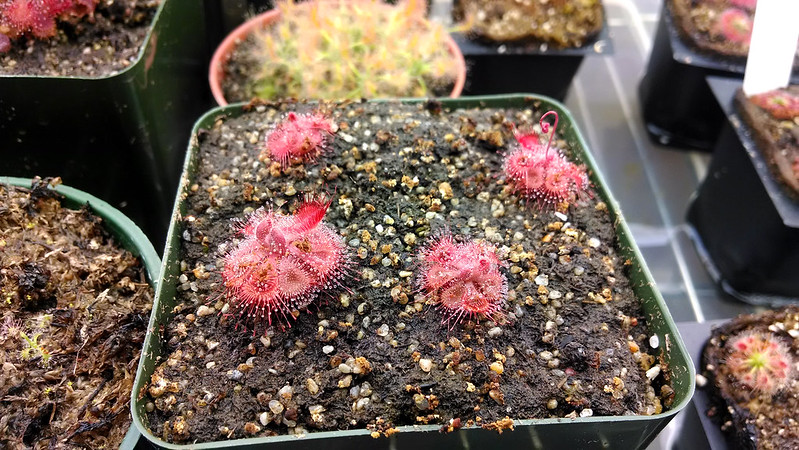This
is part of a series of posts describing my experiences with different
species, their culture requirements, and photos of their growth in my
collection. The full series can be read here, or by species at the Series page.
I love
Drosera burmannii. It's everything you could want in a sundew – easy to grow, incredibly dewy, a big (and dramatic) eater, and very handsome when mature.
 |
| May 16 2014, the five plants in my competition pot. |
These
D. burmannii come from Humpty Doo, NT, Australia. I'd had an eye out for these plants since I'd
read about them on Grow Sundews (and
watched the video). I was lucky enough to find seeds available from Crystal's Carnivores (alas, now defunct), and started them a little bit before the new year.
 |
| Feb. 15, 2014 |
I was still getting familiar with the hobby, so I used terrible Wisconsin long-fiber sphagnum from Mosser Lee that was full of sedge and twigs and which I intensely regret purchasing. Still, it worked fine for the short time I used it, and I got a decent germination rate (though nothing compared to the
D. intermedia 'Cuba' seeds I started at the same time).
 |
| Mar. 1, 2014 |
The real trick with
D. burmannii, as with all sundews I've tried so far, is food. When fed regularly sundews grow very quickly, and
D. burmannii can be fed very regularly. They were a bit slow to get started at first, since the earliest carnivorous leaves were tiny, difficult to feed, and could only take very very small amounts of food. However, once the seedlings reached a decent size (and could be fed accordingly) they fairly exploded. Consider the following two photos:
 |
| Mar. 11, 2014 |
 |
| Mar. 31, 2014 |
The plants doubled or tripled in size in only 3 weeks, compared to the extremely slow growth before. They really like food! Shortly after the above photo was taken I traded 2 of the seedlings for some
Utricularia praelonga and donated 2 more to the NASC auction, which left me with 9 plants total. Two are now starting to flower!
 |
| May 19, 2014, happily repotted. |
Honestly, if I were to recommend one sundew to people (besides the inevitable and delightful
Drosera capensis), this would be it. There are several different location forms (Humpty Doo being among the nicest-colored), but I understand that they're all pretty much as easy as they come.
One note about
Drosera burmannii: they are said to be annual, needing to be restarted from seed after flowering. However, the guide at Grow Sundews disagrees, saying that they'll pull through flowering if fed enough and kept in favorable conditions. I guess I'll have the opportunity to find out in the next few months!
 |
| May 19, 2014, having been recently fed. |
The Breakdown
- media: I've used (terrible) long-fiber sphagnum as well as the standard peat:sand and they haven't seemed to care much.
- light: As much as you can provide, but would probably be fine on a windowsill. I doubt anything but full sun or intense artificial light could produce the nice red colors, though.
- water: The tray works well, has tolerated brief periods with the tray almost dry.
- temperature: No particular restrictions, although they'd probably die if frozen.
- feeding: I feed whenever I have time and there are a couple fresh, unfed leaves (which is often). These guys can really eat.
- propagation: Easy to start from seed. Sow on a pot of media of your choice, and keep under the lights to germinate. I used plastic wrap to keep the humidity high. Acclimate the plants to lower humidity gradually and then feed as soon as possible. Mine went from seed to flowering in about 5 months.







What do you feed them and how?
ReplyDeleteI cover how I feed my sundews in the following post:
Deletehttp://www.sundews-etc.com/2014/04/cultivation-guides-feeding-sundews.html
Great reeading your post
ReplyDeleteHi great reading yyour post
ReplyDelete